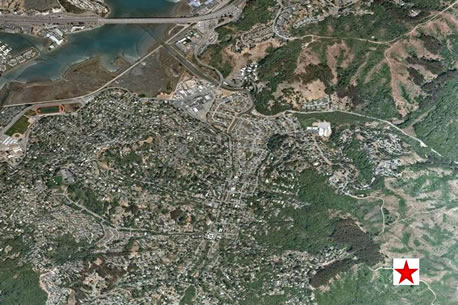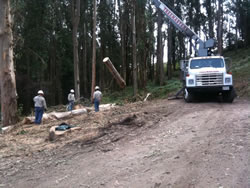National Cohesive Wildland Fire Management Strategy Success Story
Permits Reduce Hazards across the Property Line
Golden Gate National Recreation Area, California
Cohesive Strategy - Maintain and Restore Landscapes
2011

Aerial view of the Smith Road project and vicinity, in Marin County, California. The eucalyptus grove that was treated is in the lower right corner. Source: Google Earth.
Golden Gate National Recreation Area shares a 40-mile interface with developed lands in Marin, San Francisco, and San Mateo counties. Private property along the park boundary is potentially threatened by wildfire, including thousands of residential homes. Although fuel reduction projects target high priority areas, the number of requests for vegetation treatment along the boundary exceeds the available staffing and funding resources. To address the need for more vegetation treatment, the park has developed a permit system which is allowing important partnership projects to take place.

Removing eucalyptus.
The Smith Road Fuel Reduction Project in September 2011 removed 33 eucalyptus trees from the outer edge of Golden Gate National Recreation Area, along with 6 others on Marin County land and 5 on a private parcel. These trees had stood with many others, next to a neighborhood in Tamalpais Valley known for its complex emergency evacuation scenarios.
A steep winding road leads to a group of homes and ends at the boundary of the park where there is a large, eucalyptus grove, dating back to original planting in 1910. The owner of the newest home, currently under construction, wanted to reduce risk from the fire hazard associated with these trees. This owner partnered with the local fire safe council, FIRESafe Marin, by donating funds to be used for hazardous fuel removal, and FIRESafe Marin provided planning and project management. The next door neighbor had done something similar to remove 28 additional eucalyptus trees from the park boundary two years prior.
These privately funded projects are possible on National Park Service land through Stewardship Permits for Boundary Vegetation Treatment in which the private permittee assumes cost and liability for work which supports the park’s land management plans, but is not scheduled in the immediate future.
Stewardship guidelines for the Smith Road project include protecting native trees during tree removal operations to the greatest extent possible; planting and maintaining 10 coast live oaks after eucalyptus trees are removed; grinding the stumps 12 inches below the surface to prevent resprouting; and ongoing control of eucalyptus seedlings by hand-pulling. This same eucalyptus grove had been thinned by the National Park Service in 2009, as part of a series of projects funded by the American Recovery and Reinvestment Act.
Contact
Jennifer Chapman, Fire Communication and Education Specialist
Email: jennifer_chapman@nps.gov
Phone: (415) 464-5133
Key Words: Partnerships, American Recovery and Reinvestment Act (ARRA)